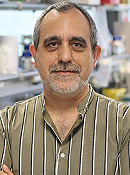José Antonio Enríquez graduated in Biochemistry and Molecular Biology from the Autonomous University of Madrid and received his doctorate from the University of Zaragoza (UniZar) in 1992. During his thesis he studied various aspects of mitochondrial DNA biogenesis (mtDNA). Between 1993 and 1997 he worked with G. Attardi at the California Institute of Technology, where he investigated the pathogenic action of mutated mitochondrial tRNAs. His work during this period helped define the molecular mechanism underlying this phenomenon and helped establish a general methodology for the study of mitochondrial tRNAs. This methodology has been applied in mitochondrial biogenesis studies, as well as in the analysis of diseases related to mtDNA. In 1997 José Antonio returned to UniZar as Assistant Professor to initiate his independent research group (GENOXPHOS), in 1999 he become Associated Professor and in 2007 Full Professor at UniZar. Dr. Enriquez joined the CNIC in 2009, where he focuses on elucidating the molecular mechanisms of mitochondrial dysfunction in cardiovascular disease and ischemic processes.
Along more than 25 years GENOXPHOS group research activity has focused on the study of mammalian mitochondrial electron transport chain (MtETC) and H+-ATP synthase, which constitute the oxidative phosphorylation system (OxPhos). Among their scientific contribution are the study:
(1) Functional consequences of the genetic variability of the mtDNA, with the most outstanding work being the demonstrate in human and mouse that the population variability of mtDNA conditions the metabolism of the organism, its response to drugs, predisposition to diseases, to healthy aging, and help explain the borderline pathology and functional variability for mtDNA alterations. Together, his contributions highlight the role of mitochondrial ROS in the adaptation of the OxPhos system to the metabolic requirements of the cell.
(2) Development of new structural organization models of the electronic mitochondrial transport. Based on the observations and methodology developed by Dr. Schägger, the works of the group GENOXPHOS is transforming the understanding of the structure and function of the mitochondrial respiratory chain, giving rise to the proposal of the "Plasticity Model" to explain the dynamic organization of the mitochondrial electron transport chain. On the one hand, this model, and the work from which it is derived, explain the functional value of associations of respiratory complexes in superstructures, describes the first protein factor genuinely required for the physical interaction between complexes. Demonstrates the dynamic organization of the respiratory chain to optimize the use of different carbon sources and provides the experimental test of the proposed plasticity model. Their research allowed to connect mitochondrial dynamics with bioenergetic function. Likewise, in the context of the plasticity model, it has been possible to explain the determinant role of the structural isoforms of the IV complex of the mitochondrial electron transport chain in its homodimerization capacity and in its capacity to interact with other complexes.
(3) The role of OxPhos in metabolic adaptation with key advance in the understanding of the processes by which cells optimize and molecularly regulate their metabolic capacity, inducing structural changes in the electronic transport chain. Unexpectedly, these adaptations are especially relevant in cardiovascular pathology and the immune system.
(4) In the context of cardiometabolic biology and pathology the group has defined the mitochondrial stress protease OMA1 as a promising target to prevent heart failure; the relevance, the relevance of the Fgr tyrosine kinase in regulating inflammation and obesity; and the discovery of the role of heart resident macrophages in the proper elimination of the cardiomyocyte damaged mitochondria.
